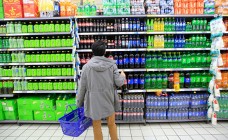The future of retail spaces is a balance of technology & people
By Retail4Growth Team | Retail4Growth Team | November 11, 2020
Technology must be used to bring retail functions together in order for it to become a meaningful facilitator, says Tim Radley, Founder of UK based VM-Unleashed, in this column.
 We have been talking about digital screens in shops forever. It has still not achieved anything near its potential. The answer is not to develop even higher quality deliverables, but to use technology to integrate them with back-end systems.
We have been talking about digital screens in shops forever. It has still not achieved anything near its potential. The answer is not to develop even higher quality deliverables, but to use technology to integrate them with back-end systems.
First, technology must be used to bring retail functions together. Immersive shop experiences rely on technology hardware, but it is the content that brings a shop to life. This is dependent on the integration of buying & merchandising and marketing functions, with shop design and visual delivery teams. It must also bring together physical locations, products, and customers. The future of retail spaces is a balance of technology and people.
Connecting in the real sense
We must also stop talking about channels. Instead, we should address the myriad of touchpoints that seamlessly connect us to our customer. Technology has the capability to bridge space and time. We should use that capability.
Across all touchpoints, retail brands must create deeper emotional relationships with customers, to instill loyalty and drive profit performance. At a basic level, they can communicate product value and “added-value,” convenience, availability & efficiency. At an advanced level, they should embrace the lifestyle of the customer, reflect their taste and aesthetics, and respond to events and activities occurring in their worlds. Ultimately, retailers can begin conversations around the customer’s well-being, ethical values, and philosophies.
Back-end technology is the tool that captures and evolves these relationships. Front-end technology is the conduit that delivers them as enhanced, customised, and personalised physical experiences.
Staticc versus dynamic
A traditional static shop-fit can be turned into a vibrant, dynamic environment. It can also be transformed into a powerful selling machine. Screens of all sizes can communicate a powerful generic brand message, delivering a changing experience relevant to seasonality, events, and product dynamics. The principle has been used with card & paper for decades, but technology not only saves money and is resource sustainable, but it adds rich-media, sound, and movement, ranging from the atmospheric to the phrenetic.
Technology can customise experiences across a portfolio of shops. Content can be edited to be relevant to a customer demographic, the location of the shop, traditions, heritage, architecture, to reflect local events, attitudes, buying patterns and even the weather. The shop retains its vibrancy and its excitement, and now also becomes relevant too.
When shops become personal, the customer response, in terms of brand engagement and sales performance, begins to fly. At this level, the physical shop is no longer a channel, but a world of touchpoints.
On the grand scale, the environmental screens can identify individual customers, instantly streaming appropriate products, lifestyle, and brand messages. The ultimate sophistication is to follow a variety of customers around the same shop simultaneously.
Up, close & personal in an omni-channel way
On an inspirational level, customers will interact with a variety of responsive screens. Attracted by relevant content, they can select to shop online, access social media platforms with direct purchasing facilities, or stream rich-media entertainment, also with single click purchasing capabilities.
On the most intimate level, customers will access the brand’s dedicated content and media on their own mobiles, in a place of relaxation or social activity within the shop. The mobile phone is the preferred way for people to engage with their own personalised world. No physical shop will change that. So the most important technology in physical shops is to supply fast, reliable, and free wi-fi access.
To achieve this level of intimacy, a retail business must coordinate high specification digital screens, outstanding immersive content, rich customer profiling, and the exceptional integration of back-end and front-end systems.
Incredibly, such personalised experiences can be further improved by turning them into “personal” ones. This is unashamedly physical and traditional. It is the face-to-face interaction between a customer and a highly trained, highly motivated, and well-informed shop colleague.
Technology will ensure the most appropriate assistant is in the right place at the right time. It will continuously update the assistant, via a hidden earpiece, on product information and availability, and the customer’s profile & buying patterns, as she speaks with them. All of this, via a voice activated, personalised application. Crucially, it will allow the assistant to be their natural, confident, engaging, and personal selves.
Technology facilitated personalised experiences and personal interactions - The stuff of dreams? No, a real and present possibility, if we would only use technology to bring together retail functions, IT systems, data sources, digital screens, and of course, retail people, once and for all.
“A traditional static shop-fit can be turned into a vibrant, dynamic environment. It can also be transformed into a powerful selling machine. Screens of all sizes can communicate a powerful generic brand message, delivering a changing experience relevant to seasonality, events, and product dynamics. The principle has been used with card & paper for decades, but technology not only saves money and is resource sustainable, but it adds rich-media, sound, and movement, ranging from the atmospheric to the phrenetic.”
Tim is Founder of VM-Unleashed Ltd, based in the UK. His expertise comes from 30 years of working with a wide variety of international brands and retail businesses across creative & commercial retail propositions. He works in physical and online stores to develop best practice in the areas of retail strategy, buying & merchandising, assortment planning, space planning, store layout and site architecture, store and site design & refreshment, visual merchandising, visual communication, retail calendar development, events & sales promotionsHis recent clients includeHalfords, Bialetti, Jack Jones, Bestseller, Ladbokes, Boots, Walgreens, Allsaints, Marks & Spencer, Carrefour, Primark, Cortefiel, Otto Versand, Sonae, Adidas, Sony, Clarks, Benetton, Ferrari, to name just a few ..


_165_265.jpg)
_165_265.jpg)





Comments